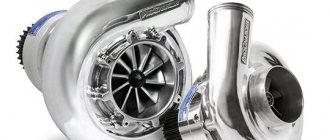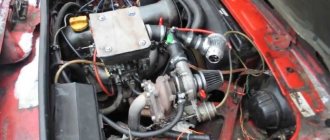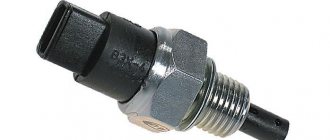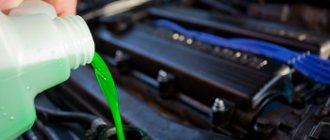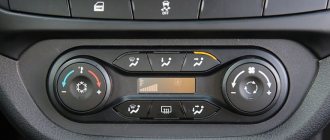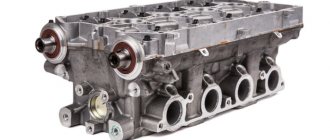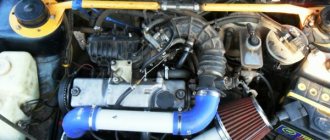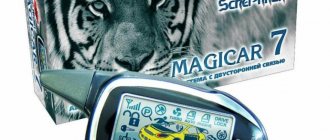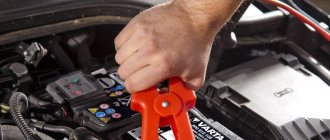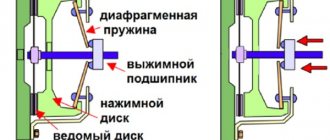The turbine is a rather complex device that increases engine power. Its breakdown, unlike many other components of the car, is not critical. But you should understand that the engine will not work normally without it, and oil and fuel leaks will not have a positive effect on the general condition of the vehicle and the car owner’s wallet. How can you understand in time that the turbine is dying? To determine the malfunction, you need to understand the principles of its operation, find out the signs and what could lead to this. However, for a more accurate diagnosis, you will need to contact a car service center or service station.
What is a turbine?
To put it simply, a turbine is a mechanical device in a car that supplies pressurized air into the combustion chamber. The main task performed by turbocharging is to significantly increase engine power without increasing its displacement. Installing a turbine provides a fifty percent, and sometimes more, increase in the power of the power unit when compared with non-turbocharged engines of the same volume. This is due to the turbine forcing air under pressure into the cylinders and increasing the oxygen content in the fuel mixture, and as a result, increasing its efficiency.
Structurally, the turbine consists of a mechanical impeller driven by the movement of vehicle exhaust gases. That is, exhaust energy is used to capture and supply air (and, accordingly, oxygen) into the system to improve the quality of the fuel mixture. From a technological point of view, today this is the most effective device for increasing engine power at the same fuel consumption, which has reduced the emission of toxic gases into the atmosphere.
Such units are widely used in both diesel power plants and gasoline engines. Moreover, in the first case, turbocharged engines turned out to be the most efficient due to the high compression ratio and low crankshaft rotation speed when compared with gasoline cars.
In addition, the limited use of turbocharging on gasoline cars is due to the possible manifestation of detonation, which occurs with a sharp increase in engine speed, as well as due to the high temperature of the exhaust gases, reaching one thousand degrees versus six hundred for diesel engines. Naturally, such temperatures can lead to damage to turbine parts.
About supercharging in simple words
They often say about supercharging: “It’s the turbine that forces more air into the engine. Power and efficiency increases.” Not at all like that. The goal of supercharging is not to increase efficiency, but to increase power and torque for the same engine size.
Supercharging is the most radical means of increasing power, which is achieved by pumping additional air into the diesel cylinders and a corresponding increase in fuel supply in the same speed range. Air without fuel does not burn, and does not increase either power or efficiency, which does not have to increase, and may even decrease.
So, boost is: air + fuel = power. The turbine does not drive air, it is supplied by the compressor. Supercharging systems differ in particular by the type of compressor drive; There are three types of supercharging:
- mechanical;
- electric;
- turbocharging
In passenger cars, the most common is turbocharging. Its difference from the first two is that it uses waste energy from exhaust gases to drive the compressor. The mechanical and electrical systems take the useful energy of the motor for their needs.
What does a turbine consist of?
Depending on the manufacturer and model, turbines have some differences, but their main structural elements and mechanisms are identical. So, the design of any turbine includes an air intake, immediately behind it an air filter, a throttle valve, a turbocharger, an intercooler and an exhaust manifold are installed. All parts of the unit are connected to each other by tubes and hoses, which are made of reliable wear-resistant materials.
Most people familiar with the design features of the car have noticed several differences between turbocharging and standard intake systems - the presence of an intercooler and turbocharger, as well as some elements for controlling and regulating the boost.
One of the main and most important elements of a turbine is the turbocharger (or turbocharger). It is this that provides increased air pressure on the engine intake lines. In its design, a turbocharger has two wheels - a turbine and a compressor, located on the rotor shaft. Each wheel is mounted in a separate, reliable housing, and the design includes a bearing.
How Vasya checks the turbine (software)
The inspection methods described above only provide an indirect assessment of the condition of a used turbine. To diagnose it in detail, it is better to use electronic means - a laptop and diagnostic software installed on it. The most common program for this among masters and car owners is “Vasya Diagnostician”. The following is a brief description of the algorithm for checking the pressure in the tested turbine. It is assumed that the car enthusiast knows how to connect to the service connector of the ECU and run the program. All further readings are performed with the machine idling, that is, with the engine and turbine running.
Checking the turbine on the Vasya machine
- In the program, select the section “Selecting a control unit”, then “Engine electronics”.
- Select the “Custom Groups” button. A window for customizable groups opens on the left and a list box opens on the right for selecting groups directly. Here is a description of all the components that affect the performance of the car engine (sensors, executable modules, and so on).
- In the list you need to select the line Absolute intake pressure or “Absolute consumed pressure”. The corresponding pressure will be presented in the left window. The units of measurement in this case are kPa instead of bars.
- When idling, the turbine pressure will be slightly more than 100 kPa (or 1 bar, for example 107 kPa).
- Along with turbine pressure, it will also be useful to include additional functions - the angle of the accelerator pedal, the torque value, the coolant temperature, and so on. This will be useful for understanding the dynamics of the turbine.
- When driving a car, the corresponding turbine pressure will increase and will be about 2...3 bar (200...300 kPa) depending on the type of turbine and driving mode.
It is recommended that before purchasing a used car, you check all its systems, including the turbine, not only visually and tactilely, but also using the described software tools like Vasya Diagnostic.
How does a faulty turbine affect the performance of a car engine?
Many people believe that a small unit in the form of a turbine, if it fails, is unlikely to have a strong negative impact on the operation of the engine, but this is not entirely true. A very common cause of turbine failure is low oil pressure or poor oil quality. A drop in pressure is often due to severe contamination of the oil filter or its poor quality, as well as as a result of using the “five-minute flush” method.
Given the high turbine speeds, as well as constant exposure to high temperatures, which are normal operating conditions, even a slight and short-term drop in pressure in the oil system can cause turbine axle bearing failure. When it is severely worn, the radial clearance increases, and this play leads to damage and failure of the seals.
With damaged oil seals, there is no proper tightness, and accordingly, oil easily enters the engine manifold. At the same time, the oil pressure in the bearings of the turbine axle drops even more, which leads to even greater damage to this unit.
The hot exhaust gas passes through the broken elements and enters the internal space of the bearings, where it increases the temperature to such an extent that all lubricants are completely burned out. This leads to complete destruction of the bearing itself. It ceases to perform its function, which leads to the breakdown of the turbine blades, the debris of which remains inside the unit.
The quality of lubrication of turbine elements greatly depends on the engine oil pump. Even a short period of operation of the unit in this mode will leave the car engine without lubricants. And what will happen to the engine when running without oil requires no explanation.
To avoid such unpleasant situations, it is important to remember the main signs of malfunction and failure of a turbocharger. If you do not pay attention to these symptoms in time and do not take appropriate measures, then the sound of the characteristic grinding of blades rubbing against the internal housing of the turbine, which leads to even greater problems, will not take long to occur. If any hint of a malfunction appears, it is better to immediately contact a car service specialist or service station.
Geometry
In modern automobile turbines, such a concept as “geometry” has appeared - a mechanism that controls the intensity of boost . By turning special blades, the direction of exhaust gas flow changes. A smaller or larger amount of them hits the impeller, the rotation speed of the turbine and the amount of injected air changes. A vacuum valve, or actuator, controls these elements.
Examples of such cars are Renault Megane 1.5 l., Nissan Pathfinder 2.5 l. The system allows you to more finely regulate the amount of air, obtaining high torque even at low speeds.
Blades are moving and sensitive elements that work in difficult conditions and are constantly washed by hot gases containing soot. They are always in motion and wear out over time: play appears in their rotary joints. The once precise mechanism resembles a door with loose hinges - it is no longer suitable for adjustment.
When a large amount of carbon deposits appears, the blades jam and stop moving. If it stops in one position, the system cannot work correctly.
This malfunction option should be taken into account when performing diagnostics. The vacuum valve may fail: if its tightness is broken, it will not be able to control the geometry.
An electronic actuator is installed on the Nissan Pathfinder. It uses a worm gear. This is a compact mechanism, but it has increased friction. The cause of the actuator malfunction is mechanical wear of the worm gear and the occurrence of a large gap in the worm gear.
But if you look even deeper, carbon deposits on the blades of the geometry unit create increased resistance and load the worm pair.
The key to the longevity of the mechanism is proper operation of the engine, proper warming up and driving in optimal modes that limit carbon formation.
Signs that the turbine is “dying”
In many cases, turbine failure occurs very quickly, there are several reasons for this: it can be, as already mentioned, a lack of oil, solid particles hitting the compressor wheel and the turbine rotor wheel, and an accident can also lead to breakdown. However, more often the turbocharger becomes unusable gradually, and the car owner has time to pay attention and take the necessary measures to eliminate the causes of the breakdown or contact specialists.
There are several of the most common signs of turbine failure. These include the following:
- the presence of extraneous noise from the turbine during operation of the power plant (whistle or hum);
- the appearance of bluish smoke from the exhaust system;
- oil consumption increases sharply;
- boost pressure drops.
To identify breakdowns in the early stages, just listen carefully to your car. For example, the car’s power has dropped or it has lost its dynamics, this indicates that the turbine is not creating enough pressure.
Sometimes this is due to increased back pressure due to severe contamination of the catalyst. This can also be caused by malfunctions of the solenoid valve (which controls the turbine vacuum), which also leads to a decrease in engine power.
If these elements are working properly, then it is worth checking the wastegate or variable geometry. Often, with an aggressive driving style, the flow of exhaust gases goes past the valve, or the variable geometry is damaged, clinging to the turbocharger housing and not directing air to the turbine wheel. In this case, the efficiency of the turbine drops significantly. If it was not possible to identify the cause of the breakdown in this way, then the turbocharger will need to be removed from the power plant.
The imminent failure of the turbine and a possible sign of a defect can also be indicated by smoke from the exhaust system.
Main symptoms of a malfunction
If this mechanism begins to malfunction, you will immediately feel it. First of all, a turbine malfunction will be reflected in the driving performance of the car. Thus, the acceleration dynamics will significantly disappear. It will be difficult for the machine to reach the desired speed, especially when going uphill or when loading. The engine will also have a harder time revving up. In fact, it will turn into an ordinary “aspirated” car. And as you know, on turbocharged cars the tachometer needle significantly “comes to life” after a certain rpm range (2 thousand or more, depending on the type of engine). If the compressor is faulty, it will rise as slowly as at the beginning.
Another sign of a malfunction is increased oil consumption. This element requires constant lubrication. In addition, the oil acts as a heat sink. Manufacturers claim that with a working turbine, a car should not lose more than two liters of oil per 10 thousand kilometers. On trucks - up to 10-15 percent of the total volume of the lubricated system. If there is a problem with oil consumption, you will notice a characteristic smell from the engine compartment. The fact is that the lubricant gets onto the hot exhaust pipe and begins to burn.
For more serious malfunctions, a characteristic noise will be heard. It could be a hum, howl or whistle. The latter is the norm for any turbine. But if the turbine whistles excessively, this is a reason to carry out diagnostics. Along with this, there will be problems with speed. The engine will no longer idle normally. The arrow will “float” or even go beyond one thousand. How to check the turbine on an engine? Below we will look at several methods.
Smoke color and exhaust smell
The appearance of smoke in the exhaust system cannot be ignored; you should take a closer look at it. The process is often accompanied by an unpleasant chemical odor, which is clearly audible when moving.
Presence of black smoke
This indicates combustion of the combustible mixture in the turbine. The defect may be caused by a lack of oxygen in the fuel system. You should check:
- all pipes and their connections for leaks;
- electronic control unit;
- air filters;
- quality of operation of the entire fuel system;
- motor.
Particular attention should be paid to filters; the most common cause of lack of air in the fuel system is a dirty filter element.
Blue smoke
This indicates that oil is entering the combustion chamber. The cause may be a leak, which lies in a problem with the turbocharger or engine. In this case, it is necessary to inspect and check all connections.
White smoke
The main reason for this defect is a clogged oil drain line. It needs to be replaced or repaired.
Symptoms and causes of disorders
The smoke that appears in the exhaust pipe soon comes into view. Along with this, a pronounced pungent odor appears, which is felt as you move.
Here are other manifestations and where to look for the root of the breakdown:
- Black smoke. This manifestation is caused by the combustion of fuel in the turbine. The difficulty arises due to a lack of air mixture in the fuel system. It is important to pay attention to: the tightness of all pipes, the ECU, the engine, the air filter (often the malfunction is rooted in it), the functionality of the fuel system;
- Milky whitish color. This often occurs due to a clogged oil drain line;
- Sky gray shade. This is where the oil enters the engine. Most likely, the root of the problem should be found in the leak. It is necessary to inspect all connections, and the reason is a breakdown of the turbine or engine;
- Increased oil consumption, oil leaks. Difficulties with the oil line may be accompanied by a decrease in air flow to the mixture. This also indicates wear and charring of the channels or axle casing;
- Decreased productivity. Appears due to lack of air. It is worth taking a good look at all the parts of the air transmission system.
Signs of turbocharger failure
As mentioned above, a bluish-gray exhaust indicates the combustion of oil in the engine cylinders, which got there from the turbocharger or engine. Black indicates air leaks, and white indicates a blockage in the oil line. The appearance of a whistle may indicate an air leak at the junction of the compressor and the engine. A grinding sound indicates abnormal friction of parts and structural elements.
In case of periodic shutdown or complete failure of the turbine, all its parts and components should be checked. The bulk of all turbocharger breakdowns are due to three reasons. About them below.
Insufficient oil pressure
It can occur due to a leak or when the oil hose is pinched, or due to improper connection to the turbine. Leads to rapid wear of the rings, shaft journal, poor lubrication and a sharp increase in temperature on the radial bearings of the turbocharger. They will need to be replaced with new ones.
Contaminated oil
It can occur due to untimely replacement of lubricant or oil filters, when water or fuel gets into the oil, as well as when using low-quality lubricants. Leads to premature wear of bearings, clogging of oil pipeline channels, and damage to the axle.
Failed elements must be replaced with new ones.
Foreign object inside turbocharger
May damage or break compressor wheel blades, resulting in reduced air pressure; turbine wheel blades; rotor. In this case, the compressor will need to replace the filter and check the intake tract for leaks. On the turbine side, the shaft needs to be replaced and the intake manifold checked.
Turbine performance check
If you suspect that the turbine is not working properly or has completely failed, then the easiest way to check is to start the car and inspect the pipes. This requires two people, so you should call an assistant.
The first step is to start the diesel engine. Then find the pipe connecting the manifold to the compressor. Next, you need to press it with your hand, and ask your assistant to press the gas pedal for several seconds. The pipe will swell greatly if the turbine is running. If no noticeable changes occur, this indicates a lack of turbocharger performance.
At the same time, you can check the appearance of the pipes themselves and the manifold. There should be no visible cracks or breaks on them. If any defects are found, you should seek help from professionals.
You can only do car diagnostics yourself. Without proper competence, you should not replace or repair vehicle components. Such intervention often leads to turbine failure and large financial costs.
You should also contact only trusted auto repair services. After all, diesel engines are different from gasoline engines, and require more in-depth knowledge and experience in troubleshooting from a specialist.
Visual inspection
At the very beginning of the diagnosis, the level and quality of the engine oil is checked. It is also very important that no foreign objects get inside the turbocharger.
Then you can begin to analyze the exhaust gas. A decrease in power and overall dynamics, as well as a black exhaust, indicates an over-enrichment of the fuel mixture. This may be caused by insufficient oxygen supplied to the cylinders due to malfunctions in the intake system. Sometimes power drops due to exhaust leaks.
To check, you will need to start the engine and listen for any extraneous noise when the turbocharger is operating. There should be no whistling or creaking sounds, noise of air escaping at the joints, etc. The pipes through which air is supplied to the motor are checked for leaks. Any leaks or damage are unacceptable. It is important to check the condition of the air filter - contamination reduces its throughput, which leads to insufficient air in the cylinders.
The appearance of white or bluish smoke can be caused by a malfunction of the compressor itself or other engine components. A sharply increased oil consumption may also indicate this problem.
Under such circumstances, the air filter and turbine rotor should be rechecked. A clogged filter does not allow enough air to pass through, and this leads to a pressure difference between the housing and the cartridge with bearings, and oil begins to flow from it and enter the compressor housing. If everything is in order here, then you should inspect the oil drain line for kinks, damage, etc.
What to check for yourself
Before contacting a service station, in some cases, you can do basic diagnostics of the car yourself.
- If smoke appears, then, regardless of the color, you need to check the air filter and the connections of the pipes. If the seal is lost, then you need to remove and replace the filter.
- How worn out the turbine is can be determined by lightly turning the rotor - there is little play, which means everything is fine, and when, while turning, the rotor even touches the housing a little, then the turbine will need to be taken in for repair.
- Inspect the turbocharger. To do this, open the hood, start the engine and clamp the tube that runs from the turbocharger to the intake manifold. An assistant should press the gas for 2-3 seconds and when the tube swells from pressure, then everything is in order, but when it is sluggish, the turbine needs repair.
- The turbine is visible. There should be no oil or other stains on its body. If you disconnect a tube that was previously pinched and oil traces appear, the turbine probably needs to be replaced.
What is the difference between checking on a gasoline engine?
On gasoline cars, the imminent failure of the turbine can be determined by the same signs. Here the exhaust turns blue or white when the car accelerates. If there are air leaks in the injection channels or if the fuel system malfunctions, black smoke appears. A white exhaust with the smell of burnt oil will indicate a lubricant leak into the exhaust system. May be caused by increased end play, circlips not holding oil pressure. If oil gets into the exhaust system, soot will form on the hot turbine wheel, which will subsequently lead to an imbalance of the unit with subsequent destruction of the bearing housing.
Diagnostics while driving
Another effective way to check a turbine is to test drive it yourself. Attention is paid to the level of dynamics. Everything is simple here. In the case of a two-liter turbocharged engine with one hundred and eighty horses, the dynamics should be eight seconds to a hundred. Simply put, we press the pedal to the floor, the car should accelerate sharply. The car picks up speed too slowly, with a clear loss of traction - the turbine is not working. There is an obvious fault.
You just need an objective assessment of the engine's thrust. In the case of a three-cylinder engine with a turbine of eighty to ninety hp, you should not expect strong traction. It is possible to determine a faulty turbine here only if the car is driving too slowly; one might say it will drag along like a turtle.
We understand the turbocharger in detail
Diagnostics is impossible without a detailed study of the part. Removing the turbine pipe will help us with this.
Then we carry out a visual inspection of the cooler wings and the internal condition of the collector. If there is no oil and obvious cleanliness, the part is serviceable. Accordingly, the opposite picture will indicate a breakdown. Large turbine output allows oil vapors to leak into the intake manifold. As a result, the casing and cooler will become oily. Due to the fact that the oil still breaks into the intake manifold, you can observe heavy smoke from the exhaust.
The next steps will be to slightly shake the cooler itself. The presence of slight play, approximately one or two millimeters, is acceptable. Now, if he’s already partying too much, such a purchase will not bring anything good. If you look closely at the surface of the turbine walls and notice cuts from the blades, then the turbine is in poor condition.
All these diagnostic methods allow ninety percent to correctly assess the performance of the turbine. In principle, the element is not complex enough to cause significant problems. The main non-working moment can be significant wear, namely the floating bearing. As a result, the increase in pressure will also consume an enormous amount of oil.
One more point regarding changes in turbine geometry. Using a dealer scanner, if available, you need to check the functionality of the actuators that are responsible for this. For comparison, you can use diagrams of changes in boost force in the car being diagnosed and in any sample. If this is not possible, then use regular gas. From this you will see how the thrust moves.
Cooler jamming occurs less often. It is recommended that you personally check the performance before purchasing a car. Which, in turn, will save you from repairs in the future and will please you with a successful purchase for many years.
What determines the price of repairing a diesel engine turbine at a car service center?
Repairing a turbine on a diesel engine begins with disassembling the compressor. Many novice motorists are sure that this is not difficult to do. However, they are actually wrong. When contacting a car service center, the price for repair work will be higher if you have not a Russian car, but a new foreign car. In addition, when the operation of the turbine is monitored by an electronic computer, repairs will be more expensive, because the technician will need to turn off the control system.
The difficulty of disassembling a turbocharger is determined by its design features. The principle here is the same: the more complex the design of the mechanism, the more expensive the repair. One way or another, a specialist will need to disassemble it, even if this process turns out to be quite lengthy.
The cost of repairing a turbine on a diesel engine also depends on the complexity of the breakdown. Therefore, it is always necessary to understand why repair work is carried out. For example, if it’s time to undergo a technical inspection and also service a turbocharger, then you will pay a small amount for such work. However, when the turbine fails, it needs to be restored, broken parts replaced, or a completely new mechanism purchased; the cost of repairs will be high.
In addition, you should select a suitable repair kit. Here the car owner must decide what to do. There can be two solutions: buy an original repair kit, the cost of which is higher, or purchase non-original parts. You can save a lot of money if you buy a repair kit made not in Europe, but in China. However, do not be fooled into thinking that non-original parts will last a long time.
Important!
At a car service center, specialists will not be able to tell you the exact cost of repairing a turbine on a diesel car without diagnosing the car. It is clear that each company has a standard price list, but the cost of work indicated in it is approximate; it may increase if the breakdown is complex.
Device disassembly process
- Unscrew the turbocharger mounts. We remove it from the engine.
- We turn out the bolts holding the snails together. We release the fans with the shaft.
- Disconnect the shaft.
- We check the integrity of all parts.
Conclusions:
- An impeller with serious defects must be replaced.
- the shaft can be ground to the size of the repair bearings (old bushings are no longer suitable).
Turbine assembly
Proceed in reverse order:
- the shaft is attached to the fans,
- snail cases are collected,
- the device is installed on the motor,
- connects to the exhaust manifold.
You can use old bolts to secure parts.
Prerequisites:
- compressor fans have been repaired, sandblasted (or new ones purchased);
- the shaft is ground, mounted with bearings that match the internal and external diameters;
- all other parts (housing, pipes, flanges, filter) comply with the standard;
- The assembled unit is tested on a test bench.
It is very difficult to make a turbine diagnostic stand yourself. The mechanical part of the device is connected to a computer. All parameters are customizable. The data is displayed on the monitor.
At this stage, it is preferable to use the diagnostic resources of the service station.
Advantages of professional tests
- the device is tested in real operating mode at different shaft speeds, including the most extreme ones;
- when tuning, resonant frequencies that can destroy the structure are eliminated;
- an optimal balance is established in the joint operation of the turbocharger and the car engine;
- provides an opportunity to evaluate the efficiency of supercharging after repair.
Turbine diagnostic equipment used in specialized auto centers also allows:
- qualitatively balance the rotor in the axial and radial directions,
- rebalance the impellers (to avoid the blades touching the body),
- check the reliable functioning of the entire turbo system without removing it from the engine.
